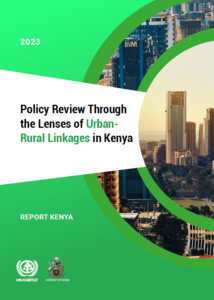Policy Review Through the lenses of Urban-Rural Linkages in Kenya
The central message of this report is that Kenya Government has, since 1963, when the country became an independent nation, committed to removing regional development imbalances. Some of such initiatives by government include construction of trunk transport and communication networks throughout the country, and designation of urban and service centres where rural communities could access services. The methodology applied in the policy review is a historical approach, which entails examining key government policies since independence.
This perspective highlights the chronological progression of efforts directed at building synergetic urban-rural linkages. This report notes that, the urban-rural linkages framework was first articulated comprehensively in the five-year National Development Plan (FYNDP) for the period 1970 to 1974, which the Government of Kenya prepared. Subsequent national development plans emphasized the need for building strong rural-urban linkages as a means of removing the glaring disparity between rural and urban areas.
The review of policies and recommendations in this report is compiled on the understanding that since the government is currently basing her development policies on Vision 2030, (Kenya 2007), which anticipates that over fifty percent of Kenyans will be living in urban areas. The government and the people of Kenya must secure, plan and service adequate supplies of land in rapidly growing urban regions in each of the 47 counties.
- Version
- Downloads 29
- Views 82
- File Size 16 MB
- Languages 1
- Date published 16 October 2023



